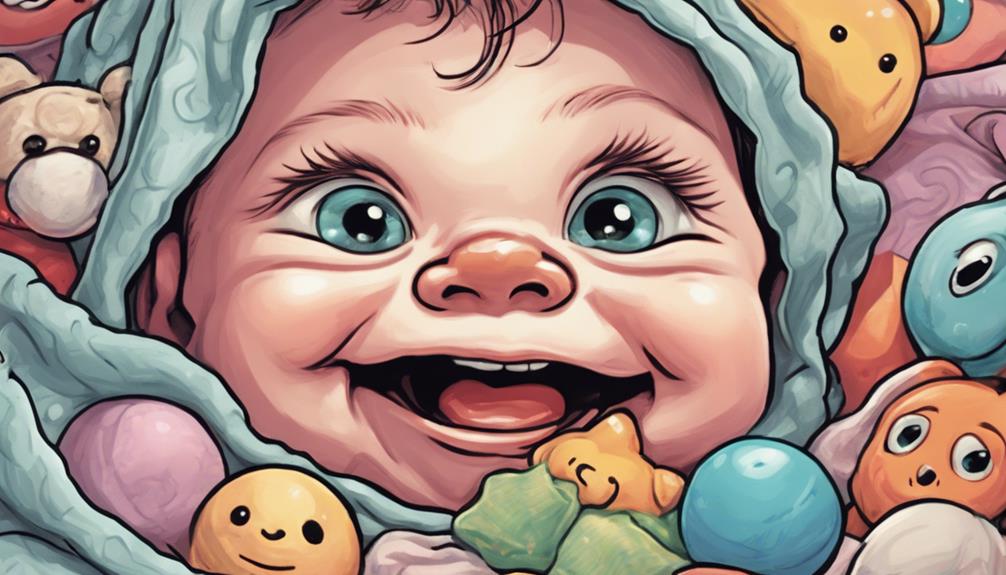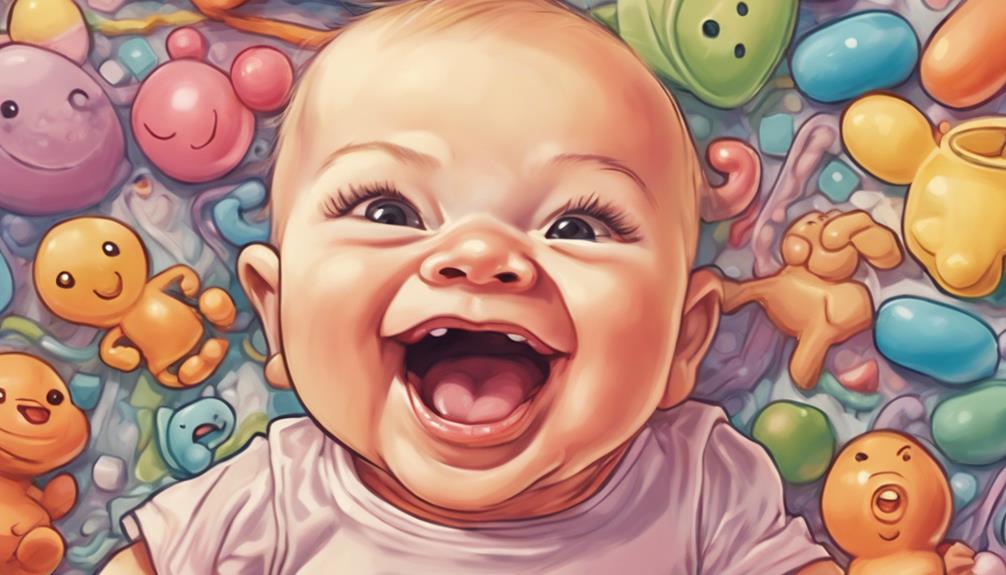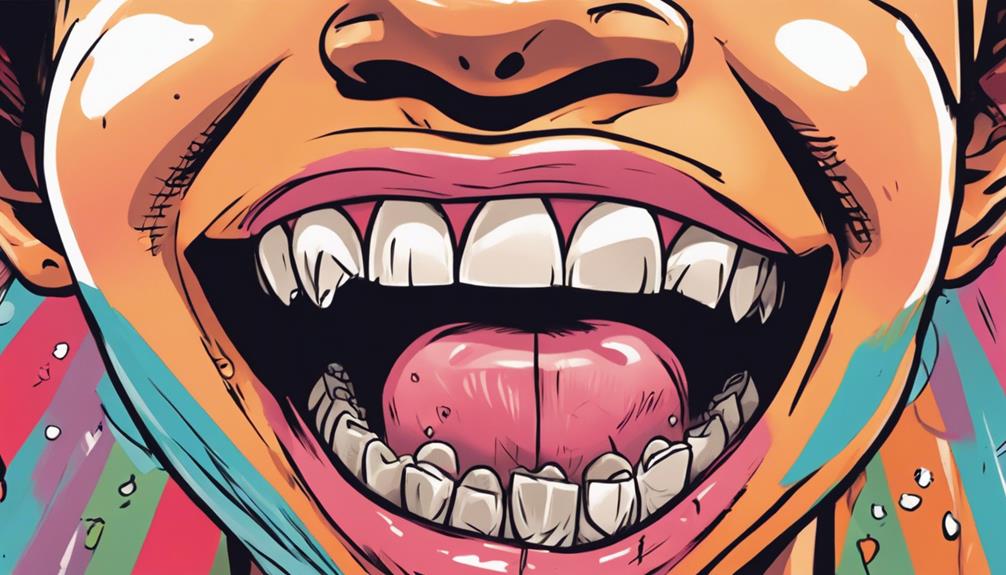Some babies are born with teeth, known as natal teeth, which appear in about 1 in 2,000 to 3,000 live births. These teeth usually manifest as lower central incisors and can be smaller and looser than typical baby teeth. Genetic factors often play a role, and some medical conditions may contribute to their occurrence. While they can be charming, natal teeth may pose feeding challenges and risks of injury. Since monitoring and care are essential, understanding how to manage these teeth effectively is vital for your baby's health and comfort. There's a lot more to explore on this topic.
Key Takeaways
- Natal teeth are present at birth in about 1 in 2,000 to 3,000 live births, often occurring due to genetic factors or medical conditions.
- They typically appear as lower central incisors and may be underdeveloped with poor root formation.
- Environmental influences like infections or malnutrition during pregnancy could contribute to the occurrence of natal teeth.
- Natal teeth can lead to feeding difficulties and pose risks of injury or aspiration for infants.
Understanding Natal Teeth
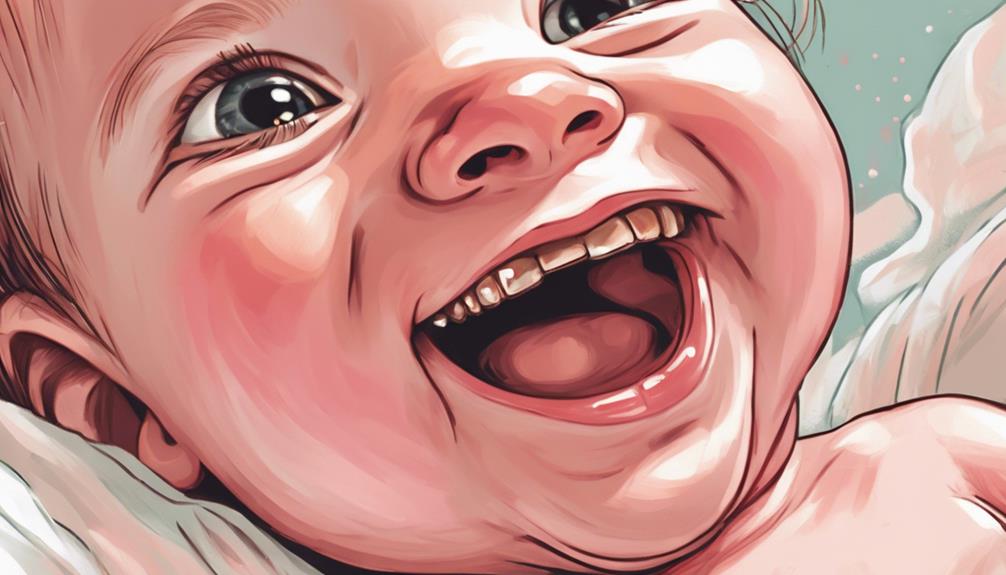
Natal teeth, which are teeth present at birth, occur in about 1 in 2,000 to 3,000 live births and are usually found in the lower jaw. These teeth can resemble primary teeth but often have noticeable differences, such as being smaller, loose, and having underdeveloped roots. Their appearance may cause concern for parents, as they can lead to complications, including feeding difficulties and risks of aspiration.
While the exact cause of natal teeth isn't fully understood, they may be linked to certain medical conditions or genetic factors. You might notice that these teeth sometimes appear discolored, which can add to the anxiety surrounding their presence. It's vital to monitor natal teeth closely, as they can pose risks to the infant's health.
Diagnosis typically involves a physical examination, and X-rays may be necessary to assess the structure and integrity of the teeth. If you find yourself in this situation, don't hesitate to consult a pediatric dentist for guidance. Understanding natal teeth is important for ensuring your baby's safety and well-being during this unique phase of infancy.
Causes of Natal Teeth
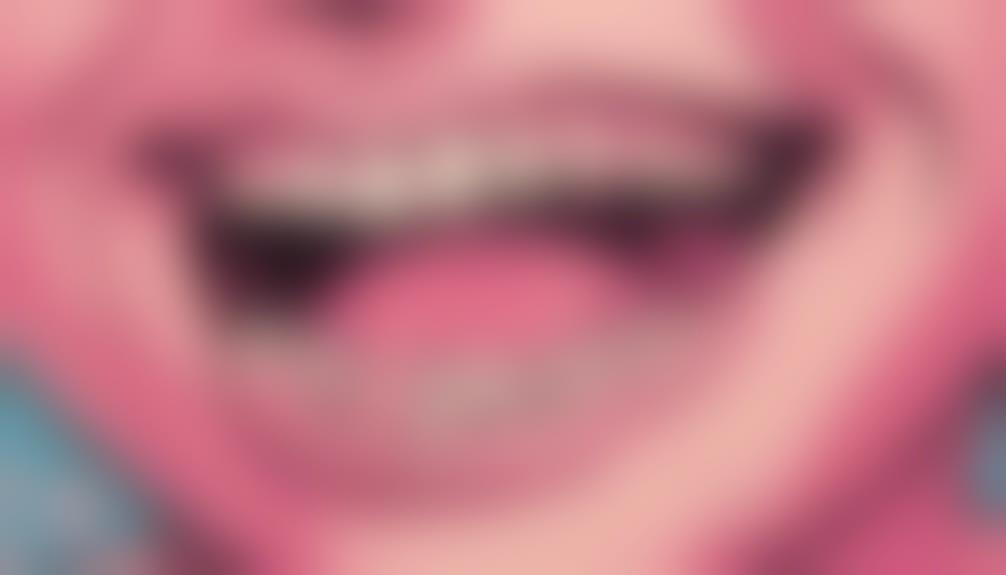
Several theories suggest that genetic factors, infections, and malnutrition during pregnancy might contribute to the occurrence of natal teeth. While the exact cause remains unclear, research points to a potential genetic predisposition, as about 15% of infants with natal teeth have a family history of the condition. If you have a family history of natal teeth, it could increase the likelihood of your baby being born with them.
Certain medical conditions also correlate with the presence of natal teeth. Infants with cleft lip and palate, as well as syndromes like Sotos syndrome and Ellis-van Creveld syndrome, are more likely to have natal teeth. This connection indicates that specific health issues may play a role in their development.
Additionally, environmental factors during pregnancy might impact the occurrence of natal teeth, although clear links are still being studied. It's crucial to be aware of these contributing factors, as understanding them can help you prepare for the possibility of natal teeth in your newborn.
Characteristics of Natal Teeth
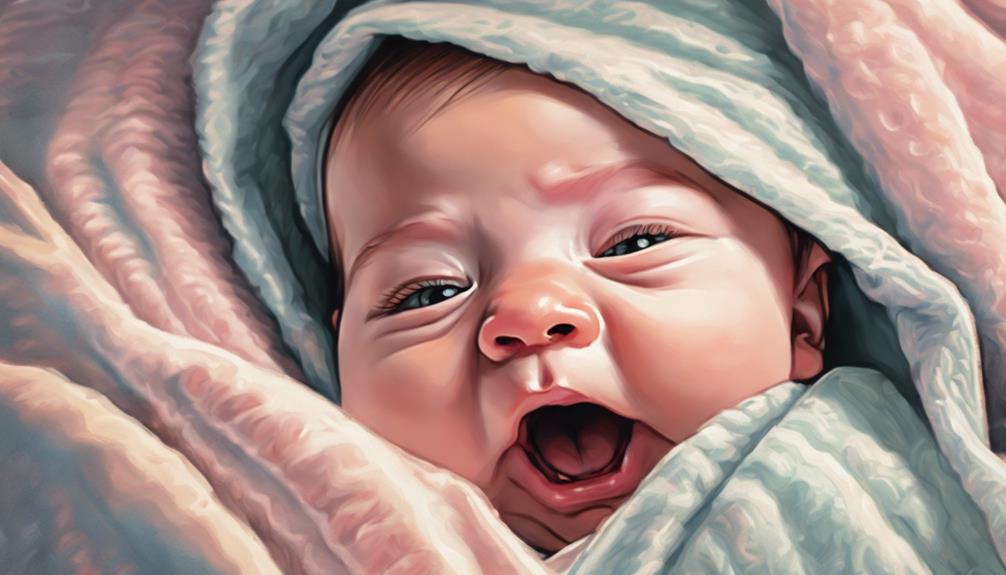
Often appearing as small, underdeveloped structures, natal teeth resemble primary teeth but usually lack proper root formation. You might notice that these baby teeth are often loose and cone-shaped, making them distinct from more developed teeth. The occurrence rate of natal teeth is around 1 in 2,000 to 3,000 births, highlighting their rarity.
Typically, you'll find natal teeth in the lower jaw, particularly as lower central incisors, although they can sometimes appear in the upper jaw. The characteristics of these teeth can vary considerably. For instance, they may exhibit hypoplastic or hypomineralized enamel, leading to issues like discoloration. You might spot some natal teeth appearing yellow or brown, which is another distinguishing feature.
Additionally, be aware that natal teeth can be associated with certain conditions, such as cleft lip and palate or Sotos syndrome. These associations can influence their characteristics and overall presence. Understanding these traits can help you recognize natal teeth and stay informed about what to expect if your baby happens to be born with them.
Complications From Natal Teeth
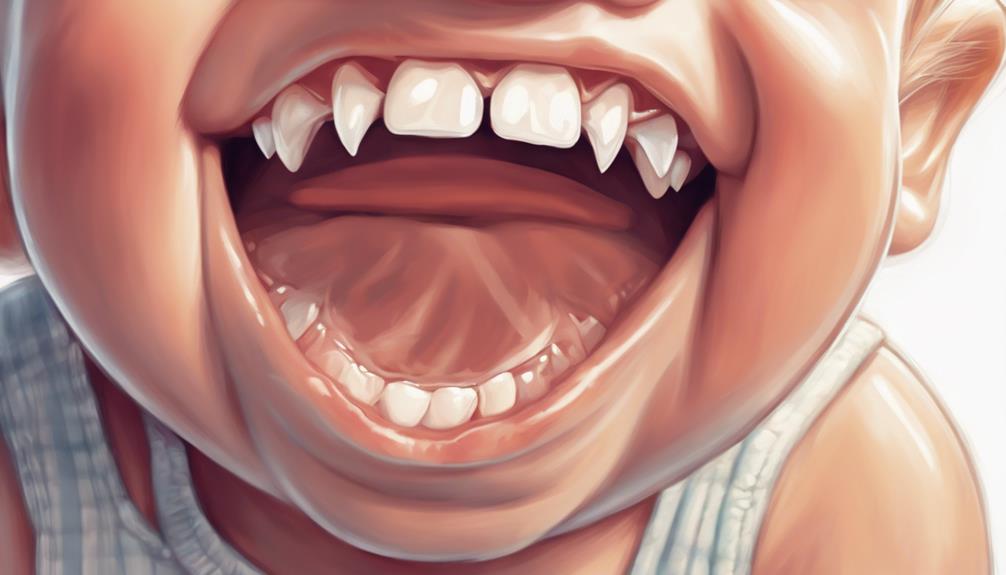
When your baby is born with teeth, you might face some unexpected challenges.
Feeding difficulties can arise, as those sharp edges may irritate their tongue or gums.
Additionally, loose natal teeth pose a risk of aspiration, which can lead to serious airway issues.
Feeding Difficulties and Risks
Babies with natal teeth can face significant feeding difficulties that may lead to pain and complications for both the infant and the mother. When these teeth are present, they can cause irritation during breastfeeding or bottle-feeding, making the process uncomfortable. For breastfeeding mothers, there's an increased risk of being bitten, which can lead to discomfort or even injury.
Moreover, natal teeth are often loosely attached, creating a choking hazard if they dislodge during feeding. The sharp edges can also injure the baby's tongue or gums, resulting in bleeding or infections that complicate feeding further. These issues can cause anxiety for parents, as they may worry about their baby's ability to feed properly and the potential for additional health issues.
If you notice feeding difficulties or signs of injury, it's essential to consult a pediatrician or dentist. Early evaluation and intervention can help address problems related to natal teeth, ensuring a smoother feeding experience for both you and your baby. Taking these steps will help mitigate risks and promote a healthier feeding environment.
Tongue and Gums Injury
Natal teeth can lead to significant injuries to the tongue and gums, causing discomfort for infants during feeding and exploration. The sharp edges of natal teeth may result in lacerations on the tongue, especially when your baby is breastfeeding or curious about their mouth. This irritation can make it painful for them to nurse effectively, which might lead to feeding difficulties.
Moreover, the presence of natal teeth can also irritate the gums, creating additional discomfort. You might notice signs like swelling or redness in your baby's mouth, indicating potential injuries. It's important to monitor these symptoms closely to prevent further complications related to their oral health.
You should also be aware that the mobility of natal teeth may increase the risk of trauma during breastfeeding. Sharp surfaces can injure your nipple, leading to pain and challenges in continuing to breastfeed successfully.
Keeping an eye on your baby's tongue and gums is vital, as early intervention can help manage any injuries caused by natal teeth and guarantee your little one is comfortable during feeding and exploration.
Potential for Aspiration Hazard
Loose natal teeth can pose a serious aspiration hazard, especially during feeding, as they may become dislodged and inhaled. The risk increases because these teeth often lack proper root formation, making them more mobile. You should be aware that around 10% of infants with natal teeth may face complications, underscoring the need for careful monitoring.
Here's a quick overview of the risks associated with loose natal teeth:
| Risk Factor | Description |
|---|---|
| Aspiration Hazard | Loose teeth can be inhaled during feeding. |
| Choking Risk | Sharp edges may cause choking if detached. |
| Tongue Irritation | Natal teeth can irritate the infant's tongue. |
| Pediatric Dentist Advice | Regular assessments can prevent complications. |
If you notice any instability in your baby's natal teeth, it's essential to consult a pediatric dentist. They can assess the situation and recommend removal if there's a significant risk of airway obstruction or feeding difficulties. Being proactive can help keep your baby safe while they navigate this developmental phase.
Diagnosing Natal Teeth
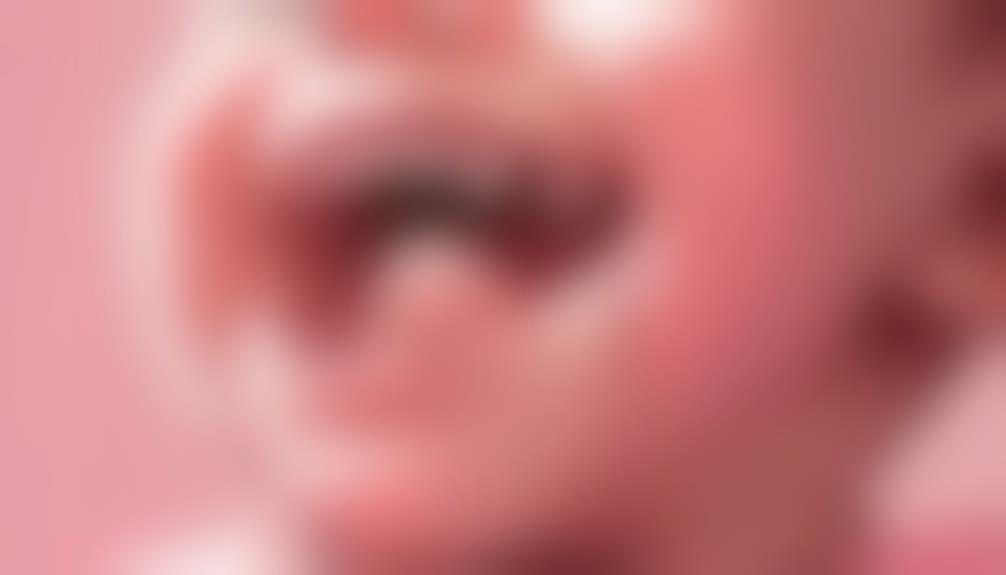
When diagnosing natal teeth, you'll start with a thorough review of the infant's medical history and a physical examination to spot any visible teeth.
Imaging techniques, like X-rays, can also help assess the structure of the teeth's roots.
Understanding these methods is essential for determining the best course of action for your baby's dental health.
Diagnostic Process Overview
Diagnosing natal teeth involves reviewing the infant's medical history and conducting a physical examination to spot any teeth present at birth. A pediatric dentist may also be consulted to evaluate the need for intervention. During the physical examination, the dentist looks for characteristics of natal teeth, which often appear discolored, underdeveloped, and loose due to inadequate root structure.
To help you understand the diagnostic process better, here's a quick overview:
| Aspect | Details |
|---|---|
| Medical History | Review of any relevant family history |
| Physical Examination | Visual inspection for teeth presence |
| X-ray Imaging | Assess underlying root structure |
| Symptoms | Evaluate for choking or feeding issues |
| Pediatric Dentistry | Consultation for intervention if needed |
If natal teeth are present, the decision to remove them depends on the potential risks and the infant's overall health. Monitoring is essential to guarantee there are no complications. The combination of thorough evaluation and professional guidance helps guarantee the best outcomes for your baby.
Physical Examination Findings
During a physical examination, healthcare providers can identify natal teeth by observing their distinctive features right after birth.
You'll notice that these teeth are typically located in the lower jaw and may exhibit various characteristics. They're often smaller than regular baby teeth, loose, and may show signs of discoloration. Additionally, the roots of natal teeth might be underdeveloped, which can be an important aspect of the diagnosis.
Your healthcare provider will also review the medical history to identify any genetic or health-related factors associated with the presence of natal teeth. This thorough approach helps in confirming the diagnosis based on the unique appearance and any related symptoms.
If necessary, further assessment can be conducted to determine if the natal teeth require management or removal, especially if they pose a risk of aspiration or other complications.
Understanding these physical examination findings is vital for you and your healthcare team, as it guides the decisions regarding your baby's oral health. By recognizing the signs of natal teeth early on, you can guarantee the best care for your newborn.
Imaging Techniques Utilized
Imaging techniques, like dental X-rays, play an essential role in evaluating the structure and development of natal teeth. When you notice these early arrivals, dental professionals may recommend X-rays to assess the root structure and overall health of the teeth. This is important for differentiating between fully formed teeth and those that are underdeveloped or lack roots, helping guide management decisions.
Radiographic imaging is particularly useful in identifying potential complications associated with natal teeth. For instance, it can highlight risks of aspiration or feeding difficulties that may arise if the teeth aren't properly formed.
Additionally, imaging techniques can help detect any accompanying dental anomalies that could affect your infant's oral health.
Treatment Options for Natal Teeth
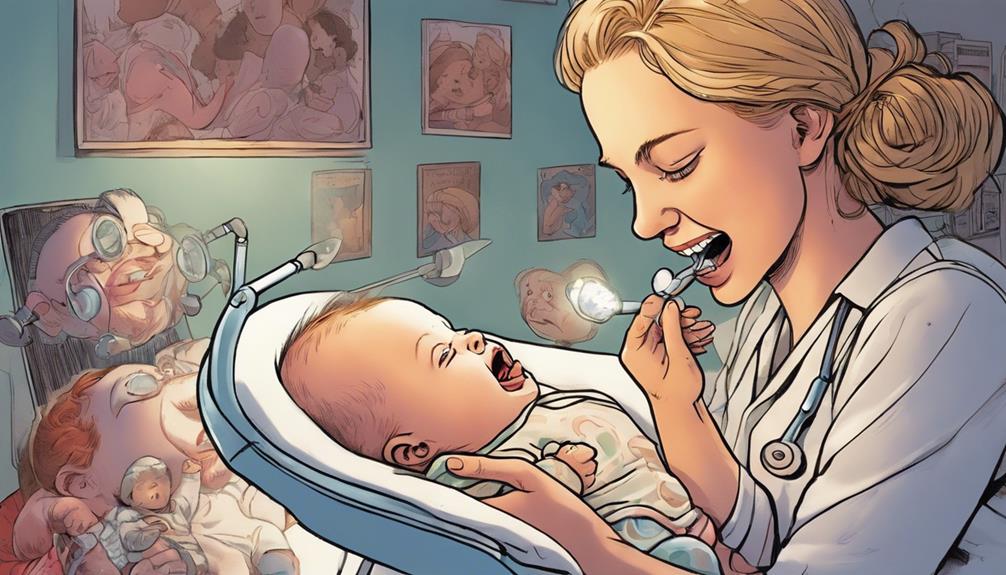
Treatment options for natal teeth depend on their condition, ranging from monitoring to extraction if they're loose or problematic.
If you notice that your baby's natal teeth are loose, it's vital to consult a pediatric dentist. They might recommend extraction shortly after birth to prevent choking risks during feeding. Dental x-rays can help evaluate the root structures, guiding the decision on whether removal is necessary.
In cases where the natal teeth are stable and well-formed, observation might be enough. However, regular dental check-ups are essential for monitoring potential issues. During these visits, your pediatric dentist can provide tailored advice on maintaining oral hygiene for your infant, ensuring both their teeth and gums stay healthy.
It's important to stay proactive about your baby's dental health. Keeping an eye on the condition of their natal teeth can help you catch any problems early on. By following your pediatric dentist's recommendations and maintaining proper oral hygiene, you can support your child's dental development effectively.
Myths About Natal Teeth

Many parents hold misconceptions about natal teeth that can lead to unnecessary worry and confusion. For instance, some believe that babies with natal teeth are more mature or healthier than those without them. In reality, these teeth can appear in otherwise healthy infants, regardless of their maturity.
Another common myth is that natal teeth will simply fall out on their own. However, many cases require dental intervention, especially if the teeth are loose or create a choking hazard.
It's also a misconception that all natal teeth signal dental issues. Not every case leads to complications, and some teeth may be stable and require no removal. Many parents fear that their infants will experience pain from these teeth, but many babies with natal teeth don't feel discomfort if the teeth are well-formed and secure.
Finally, some believe that natal teeth are solely linked to genetic or medical conditions. In fact, they can occur sporadically in healthy infants for no identifiable reason.
Understanding these myths can help you approach the situation with clarity and reduce unnecessary anxiety about your baby's dental health.
Monitoring and Home Care

To guarantee your baby's oral health, regularly check their mouth for any signs of injury or discomfort related to their natal teeth. Monitoring your baby's oral hygiene is essential in these early stages.
Here are three key steps to follow:
- Gently wipe your baby's gums and natal teeth with a damp cloth after feedings to prevent irritation and infection.
- Look out for excessive drooling or difficulty feeding, as these could signal complications associated with natal teeth.
- Consult a pediatric dentist if you notice signs of a sore tongue or mouth, or if you have concerns about the natal teeth.
When to Seek Medical Advice
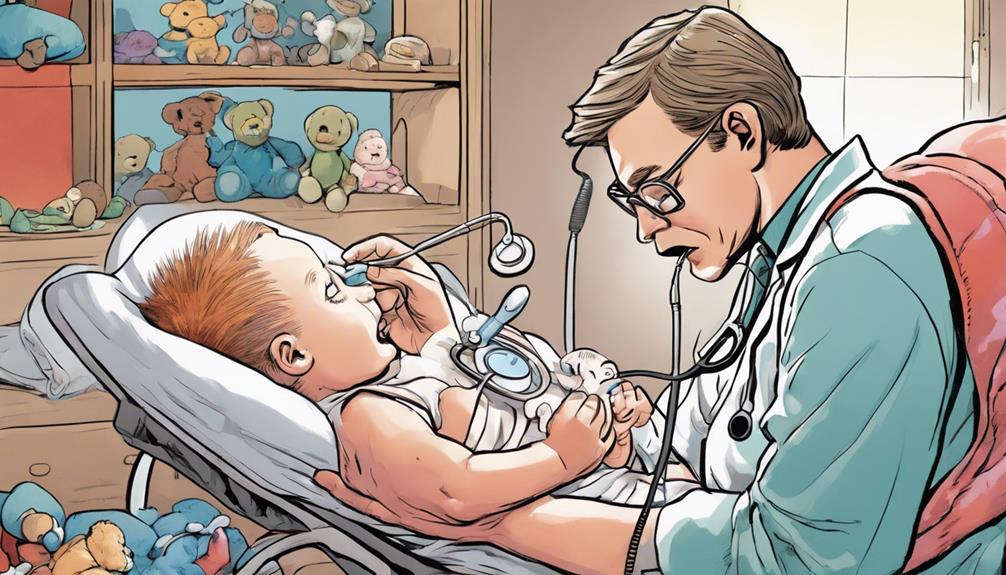
Knowing when to seek medical advice for your baby's natal teeth is essential for ensuring their comfort and health. If you notice any signs of irritation, such as a sore tongue or mouth, it's important to consult a healthcare professional. Excessive drooling or difficulty feeding may also indicate feeding complications related to natal teeth.
Here's a quick guide to help you decide when to reach out for medical advice:
| Signs to Watch For | What It May Indicate | Action to Take |
|---|---|---|
| Sore tongue or mouth | Possible irritation or injury | Contact your pediatric dentist |
| Excessive drooling | Potential feeding complications | Seek medical advice |
| Swelling or redness in the mouth | Possible infection | Consult a healthcare professional |
If natal teeth have sharp edges causing discomfort during breastfeeding, medical intervention may be necessary to alleviate the issue. Early intervention can prevent long-term complications, so don't hesitate to report any concerns you have regarding your baby's natal teeth. Always prioritize your child's well-being by staying informed and proactive.
Pediatric Dental Expertise
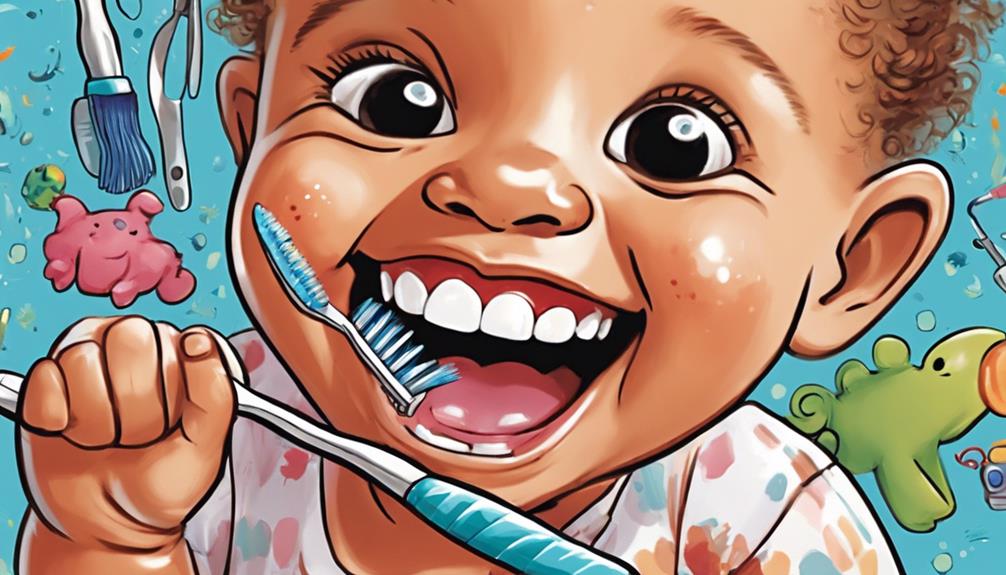
If you have concerns about your baby's natal teeth, a pediatric dentist can provide specialized care tailored to their unique needs. These dental professionals are trained to address the specific challenges that come with natal teeth, ensuring your child receives the best dental care possible.
Here's why consulting a pediatric dentist is essential:
- Expert Evaluation: Pediatric dentists are skilled at identifying and managing dental issues related to natal teeth. They know what to look for and how to address any complications.
- Child-Friendly Environment: Their practices are designed to be welcoming and less intimidating for young patients, which helps ease anxiety and fosters a positive dental experience.
- Preventive Education: They emphasize the importance of early dental visits and provide valuable oral health education for parents, helping you understand how to care for your child's teeth from the start.
Frequently Asked Questions
Is It Normal to Give Birth to a Baby With Teeth?
It's rare but not unheard of for babies to be born with teeth. If your baby has natal teeth, don't worry too much; they're usually harmless, though you might want to consult a pediatrician.
Why Are Humans Born With Baby Teeth?
Did you know that about 1 in 2,000 babies are born with teeth? Humans develop these baby teeth, or natal teeth, due to genetic factors, although their exact origins remain a medical mystery. Doctors and researchers are still trying to understand why baby upper teeth emerge more frequently than lower ones. Some studies have suggested a possible link between natal teeth and certain syndromes or metabolic disorders, but more research is needed to confirm these associations. Understanding why baby upper teeth appear more frequently could also lead to advancements in prenatal and infant dental care.
Are Natal Teeth Good or Bad?
Natal teeth can be both good and bad. They may help with early chewing and oral development, but they also pose risks like feeding difficulties and potential injury, so careful evaluation is essential for your baby's health.
What Causes Babies to Get Teeth Early?
You might wonder why some babies get teeth early. It's often linked to genetics, infections, or pregnancy issues. The mystery deepens as certain medical conditions and family histories also play a role in this rare phenomenon.
Is Astrology Linked to the Phenomenon of Babies Being Born With Teeth?
There is no scientific evidence supporting the connection between astrology and babies being born with teeth. The presence of teeth at birth is usually a genetic anomaly or a medical condition. It is important to consult healthcare professionals to understand the reasons behind why baby upper teeth astrology phenomenon.
Is Astrology Linked to the Reason Why Babies Are Born with Teeth?
The belief in baby upper teeth astrology insight is rooted in cultural traditions, but there is no scientific evidence to support a connection between astrology and the timing of a baby’s teeth eruption. The development of a baby’s teeth is influenced by genetics and other biological factors, not astrological signs.
Conclusion
In summary, while the emergence of natal teeth can be a surprising twist in the journey of new parenthood, it's often a benign occurrence.
With proper monitoring and care, you can navigate any potential complications that may arise.
Embracing this unique phenomenon can enrich your experience, turning what might seem like a concern into a charming quirk of your baby's development.
Remember, staying informed and consulting pediatric dental experts can help guarantee your little one's smile remains bright and healthy.
